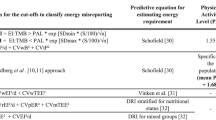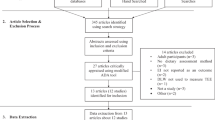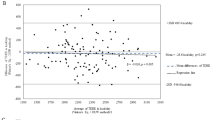Abstract
Background:
Estimating dietary intake is important for both epidemiological and clinical studies, but often lacks accuracy.
Objective:
To investigate the accuracy and validity of energy intake estimated by an easy-to-use semiquantitative food record (EISQFR) compared to total energy expenditure (TEE) estimated by doubly labelled water technique (EEDLW).
Design:
TEE was measured in 29 nonobese subjects using the doubly labelled water method over a period of 14 days. Within this period, subjects reported their food consumption by a newly developed semiquantitative food record for 4 consecutive days. Energy intake was calculated using the German Food Code and Nutrition Data Base BLS II.3.
Results:
A good correlation was observed between EISQFR and EEDLW (r=0.685, P<0.001). The mean difference between EISQFR and EEDLW was −1.7±2.6 MJ/day (−14±21%, P=0.002). An underestimation of EISQFR <10% was observed in nine subjects (31%), of 10–20% in six subjects (21%), and of >20% in nine subjects (31%). In five subjects (17%), an overestimation of EISQFR was observed.
Conclusions:
The easy-to-use semiquantitative food record provided good estimates of EI in free-living and nonobese adults without prior detailed verbal instructions. The presented food record has limitations regarding accuracy at the individual level.
This is a preview of subscription content, access via your institution
Access options
Subscribe to this journal
Receive 12 print issues and online access
$259.00 per year
only $21.58 per issue
Buy this article
- Purchase on Springer Link
- Instant access to full article PDF
Prices may be subject to local taxes which are calculated during checkout



Similar content being viewed by others
References
Auswertungs- und Informationsdienst für Ernährung, Landwirtschaft und Forsten e.V. (1991): MONICA Mengenliste. AID Spezial 1, 1–41. Bonn.
Barrett-Connor E (1991): Nutrition epidemiology: how do we know what they ate? Am. J. Clin. Nutr. 54, 182S–187S.
Bingham SA & Day NE (1997): Using biochemical markers to assess the validity of prospective dietary assessment methods and the effect of energy adjustment. Am. J. Clin. Nutr. 65, 1130S–1137S.
Black AE (2000a): Critical evaluation of energy intake using the Goldberg cut-off for energy intake: basal metabolic rate. A practical guide to its calculation, use and limitations. Int. J. Obes. Relat. Metab. Disord. 24, 1119–1130.
Black AE (2000b): The sensitivity and specificity of the Goldberg cut-off for EI:BMR for identifying diet reports of poor validity. Eur. J. Clin. Nutr. 54, 395–404.
Black AE, Prentice AM & Coward WA (1986): Use of food quotients to predict respiratory quotients for the doubly labeled water method of measuring energy expenditure. Hum. Nutr. Clin. Nutr. 40C, 381–391.
Black AE, Prentice AM, Goldberg GR, Jebb SA, Bingham SA, Livingstone MB & Coward WA (1993): Measurements of total energy expenditure provide insights into the validity of dietary measurements of energy intake. J. Am. Diet. Assoc. 93, 572–579.
Bland JM & Altman DG (1995): Comparing methods of measurement: why plotting difference against standard method is misleading. Lancet 346, 1085–1087.
Block G, Hartman AM, Dresser CM, Carroll MD, Gannon J & Gardner L (1986): A data-based approach to diet questionnaire design and testing. Am. J. Epidemiol. 124, 453–469.
Cole TJ & Coward WA (1992): Precision and accuracy of doubly labeled water energy expenditure by multipoint and two-point methods. Am. J. Physiol. 263, E965–E973.
Coward WA (1991): Measurement of energy expenditure: the doubly-labelled-water method in clinical practice. Proc. Nutr. Soc. 50, 227–237.
Federal Institute for Health Protection of Consumers and Veterinary Medicine (1999): The German Food Code and Nutrient Data Base (BLS II.3): Conception, Structure and Documentation of the Data Base Blsdat. Berlin, Germany: BgVV Publications.
Fraser GE (2003): A search for truth in dietary epidemiology. Am. J. Clin. Nutr. 78, 521S–525S.
Gibson RS (1990): Principles of Nutritional Assessment. New York, NY: Oxford University Press.
Hill RJ & Davies PS (2001): The validity of self-reported energy intake as determined using the doubly labelled water technique. Br. J. Nutr. 85, 415–430.
Hoffmann I, Groeneveld MJ, Boeing H, Koebnick C, Golf S, Katz N & Leitzmann C (2001): Giessen Wholesome Nutrition Study: relation between a health-conscious diet and blood lipids. Eur. J. Clin. Nutr. 55, 887–895.
Hoffmann I, Kohl M, Groeneveld M & Leitzmann C (1994): Development and validation of a new instrument to measure food intake. Am. J. Clin. Nutr. 59, 284S.
Kant AK (2002): Nature of dietary reporting by adults in the third National Health and Nutrition Examination Survey, 1988–1994. J. Am. Coll. Nutr. 21, 315–327.
Lissner L (2002): Measuring food intake in studies of obesity. Public Health Nutr. 5, 889–892.
Livingstone MB & Black AE (2003): Markers of the validity of reported energy intake. J. Nutr. 133 (Suppl 3), 895S–920S.
Luhrmann PM, Herbert BM, Gaster C & Neuhauser-Berthold M (1999): Validation of a self-administered 3-day estimated dietary record for use in the elderly. Eur. J. Nutr. 38, 235–240.
Martin LJ, Su W, Jones PJ, Lockwood GA, Tritchler DL & Boyd NF (1996): Comparison of energy intakes determined by food records and doubly labeled water in women participating in a dietary-intervention trial. Am. J. Clin. Nutr. 63, 483–490.
Meyer H, Schonicke L, Wand U, Hubberten HW & Friedrichsen H (2000): Isotope studies of hydrogen and oxygen in ground ice-experiences with the equilibration technique. Isotopes. Environ. Health Stud. 36, 133–149.
Prentice AM, Black AE, Coward WA, Davies HL, Goldberg GR, Murgatroyd PR, Ashford J, Sawyer M & Whitehead RG (1986): High levels of energy expenditure in obese women. BMJ 292, 983–987.
Rothenberg E, Bosaeus I, Lernfelt B, Landahl S & Steen B (1998): Energy intake and expenditure: validation of a diet history by heart rate monitoring, activity diary and doubly labeled water. Eur. J. Clin. Nutr. 52, 832–838.
Schoeller DA (2002): Validation of habitual energy intake. Public Health Nutr. 5, 883–888.
Thielecke F, Moseneder J, Kroke A, Klipstein-Grobusch K, Boeing H & Noack R (1997): Determination of total energy expenditure, resting metabolic rate and physical activity in lean and overweight people. Z. Ernahrungswiss 36, 310–312.
Thompson FE, Moler JE, Freedman LS, Clifford CK, Stables GJ & Willett WC (1997): Register of dietary assessment calibration-validation studies: a status report. Am. J. Clin. Nutr. 65, 1142S–1147S.
Thompson FE & Subar AF (2001): Dietary assessment methods. In Nutrition on the Prevention and Treatment of Disease eds AM Coulston, CL Rock & ER Monsen, pp 3–30. San Diego: Academic Press.
Tomoyasu NJ, Toth MJ & Poehlman ET (1999): Misreporting of total energy intake in older men and women. J. Am. Geriatr. Soc. 47, 710–715.
Trabulsi J & Schoeller DA (2001): Evaluation of dietary assessment instruments against doubly labeled water, a biomarker of habitual energy intake. Am. J. Physiol. Endocrinol. Metab. 281, E891–E899.
Union Deutsche Lebensmittelwerke (1997): Mengenlehre für die Deutsche Küche [Set Theory for Kitchen]. Hamburg: Union Deutsche Lebensmittelwerke.
Weir JB (1990): New methods for calculating metabolic rate with special reference to protein metabolism. 1949. Nutrition 6, 213–221.
Willett WC (1998): Nutritionaly Epidemiology, 2nd Edition, New York, Oxford: Oxford University Press.
Acknowledgements
This study was carried out with financial support from the Commission of the European Communities, BodyLife IST-2000-25410, specific RTD programme ‘User-friendly Information Society’. It does not necessarily reflect its views and in no way anticipates the Commission's future policy in this area. We thank Silvie Pester, Dagmar Vulprecht and Eileen Nebel for their technical assistance and all the subjects that participated in this study.
Author information
Authors and Affiliations
Corresponding author
Additional information
Guarantor: C Koebnick.
Contributors: IH, CK, AF, KW and GD designed the food record. CK, ALG, KW, AH and CL contributed to the design of the study. KW, GD, UT conducted the study. CK, KW, PL, ALG and UT were responsible for the data management, statistical analysis and interpretation of the data. FT, GD, HM contributed to the analysis of the DLW samples. CK, AH, GD, KW, ALG and UT performed the literature research. All authors contributed to the data collection and writing of the manuscript. HJFZ is the principal investigator and contributed to all parts of the study.
Rights and permissions
About this article
Cite this article
Koebnick, C., Wagner, K., Thielecke, F. et al. An easy-to-use semiquantitative food record validated for energy intake by using doubly labelled water technique. Eur J Clin Nutr 59, 989–995 (2005). https://doi.org/10.1038/sj.ejcn.1602200
Received:
Revised:
Accepted:
Published:
Issue Date:
DOI: https://doi.org/10.1038/sj.ejcn.1602200
Keywords
This article is cited by
-
The impact of body composition on the degree of misreporting of food diaries
European Journal of Clinical Nutrition (2023)
-
Erhebung der Energieaufnahme bei Kindern und Jugendlichen
Monatsschrift Kinderheilkunde (2013)
-
Joint association of physical activity/screen time and diet on CVD risk factors in 10-year-old children
Frontiers of Medicine (2012)
-
Arabinoxylan consumption decreases postprandial serum glucose, serum insulin and plasma total ghrelin response in subjects with impaired glucose tolerance
European Journal of Clinical Nutrition (2007)
-
Increase in serum resistin during weight loss in overweight subjects is related to lipid metabolism
International Journal of Obesity (2006)



